Of all of the notable templates holes that architects C.B. Macdonald, Seth Raynor and Charles Banks popularized in the 1910s and 20s (what Macdonald called “ideal holes” including the Redan, Biarritz and Cape), the Punchbowl is usually the most whimsical and enjoyable to play. Because of their strange shapes with sunken greens surrounded on three and sometimes all sides by mounds that kick semi-blind shots toward the middle—and sometimes fortuitously toward the hole—Punchbowls tend to be showpieces, and also curiosities.
Unlike templates that have direct antecedents in British links like the Alps or Road, (Prestwick’s and St. Andrews’ 17ths, respectively), Punchbowls don’t originate from any specific hole, though some have suspected that the ninth green at Royal Liverpool (played as the 11th during Open Championships) might be one of the first models.
Greens at many early links commonly possessed some type of shielded or punchbowl effect, since turf nestled down in dunes was better protected from the effects of the ravaging winds. Those like the 14th and 15th at Cruden Bay, which sit in bowl-like hollows, and the Dell Hole at Lahinch in Ireland, hidden between two steep dunes that funnel shots inward, are well-known examples. Punchbowls also adhere to no particular pattern or style. They can be virtually any shape, orientation, size or height—from the low inverted-frisbee version of Camargo’s seventh hole to the towering fortress at The Lido.
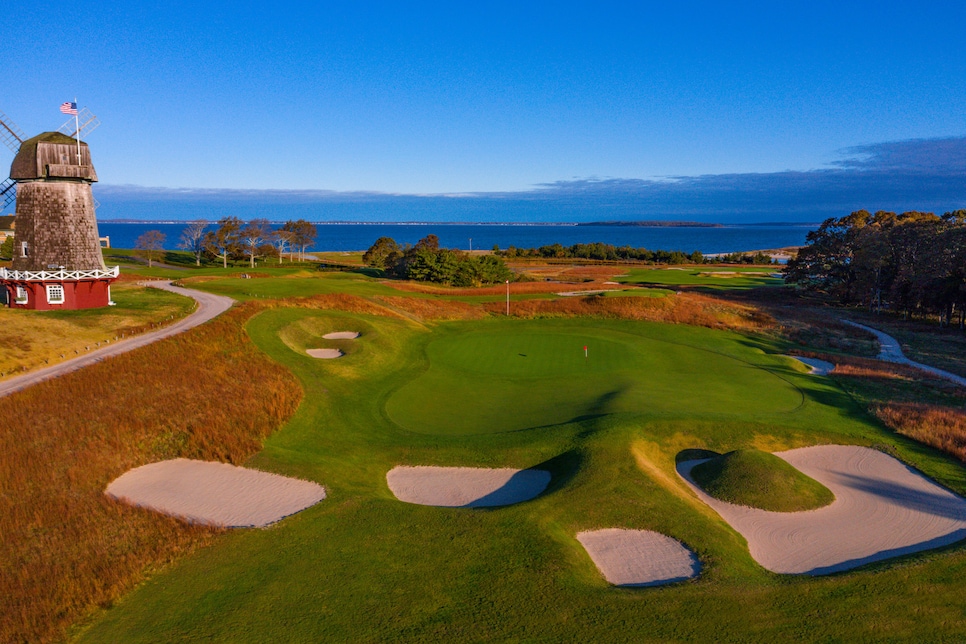
National Golf Links
Macdonald, Raynor and Banks included a Punchbowl in most of their U.S. designs, traditionally using them for putting surfaces behind the obscuring mound on the Alps hole, and occasionally as standalone greens, including the 16th hole at National Golf Links of America. But very few, if any, Punchbowls were constructed in the U.S. after the 1930s when Macdonald, Raynor and Banks had all either passed away or retired. Architecture in the post-World War II period and beyond became more technical and focused on modern equipment and ease of maintenance, leaving little appetite for the quirkiness of these holes.
Golf Digest architecture editor emeritus Ron Whitten recalls that Rees Jones built a type of punchbowl-style green at the Country Club of Hilton Head in the late 1980s, but it wasn’t until the late 1990s that architects began to once again experiment with them widely. Brian Silva built Punchbowl greens at Olde Scotland Links and Black Rock in Massachusetts, and at Black Creek Club in Tennessee. Jim Engh expanded their versatility by creating profound punchbowl sections within larger serpentine greens. Others tinkered as well.
Since the 2000s, Punchbowl greens have become once-again popular resources that architects use in both revivals of Macdonald and Raynor designs and at original courses. They’re coming to us, as good ones should, in strange shapes and sizes.
Below you’ll find our spotlight of some of our favorite contemporary Punchbowl greens.
We urge you to click through to each individual course page for bonus photography, drone footage and reviews from our course panelists. Plus, you can now leave your own ratings of the courses you’ve played. Which are you favorite Punchbowls? Search for courses and leave your own review here.
APOGEE CLUB WESTHobe Sound, Fla. 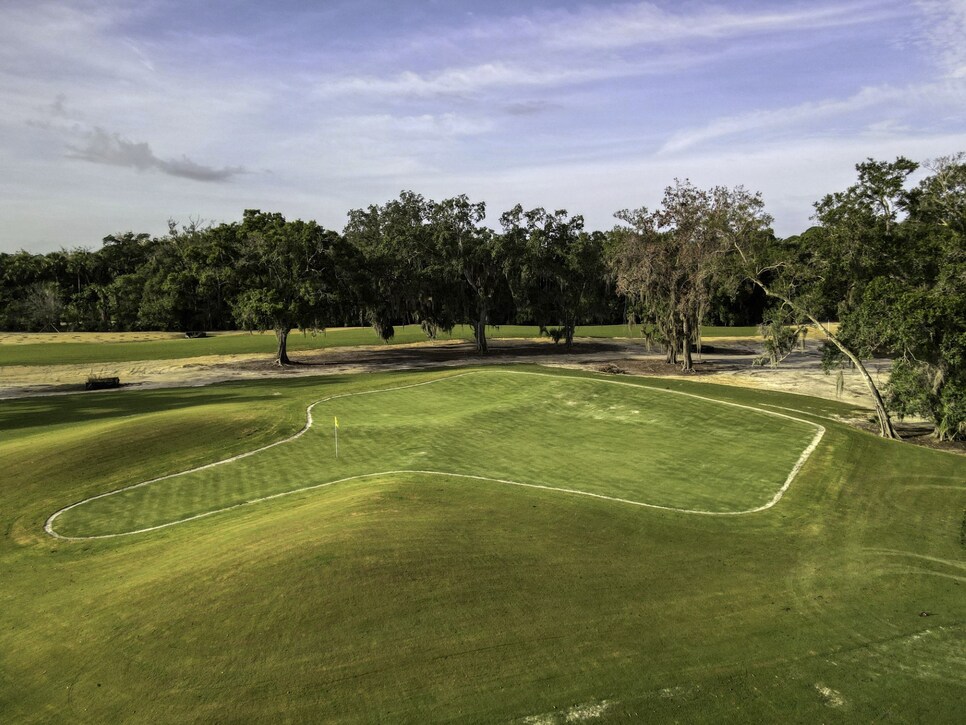
Apogee West
Jensen Larsen
The 14th green at this newly opened club in Martin County, Fla., 15 miles north of Jupiter, is really three punchbowls in one. The drivable par 4, designed by Gil Hanse and Jim Wagner, features a low front section of green that dips between two Mae West-like mounds, and left and right back bowls each divided by ridges. Think of hitting shots—or drives—into a green modeled on the Mercedes-Benz logo, and the up-and-over putts that might result from placing your ball on the wrong third. Hanse and Wagner also built Punchbowl greens at The Park, a new public course in West Palm Beach (2023), and at The Match at Jonathan’s Landing in Jupiter (2021), giving them three now in a 35-mile stretch off of I-95.
BLACK CREEK CLUBChattanooga, Tenn. 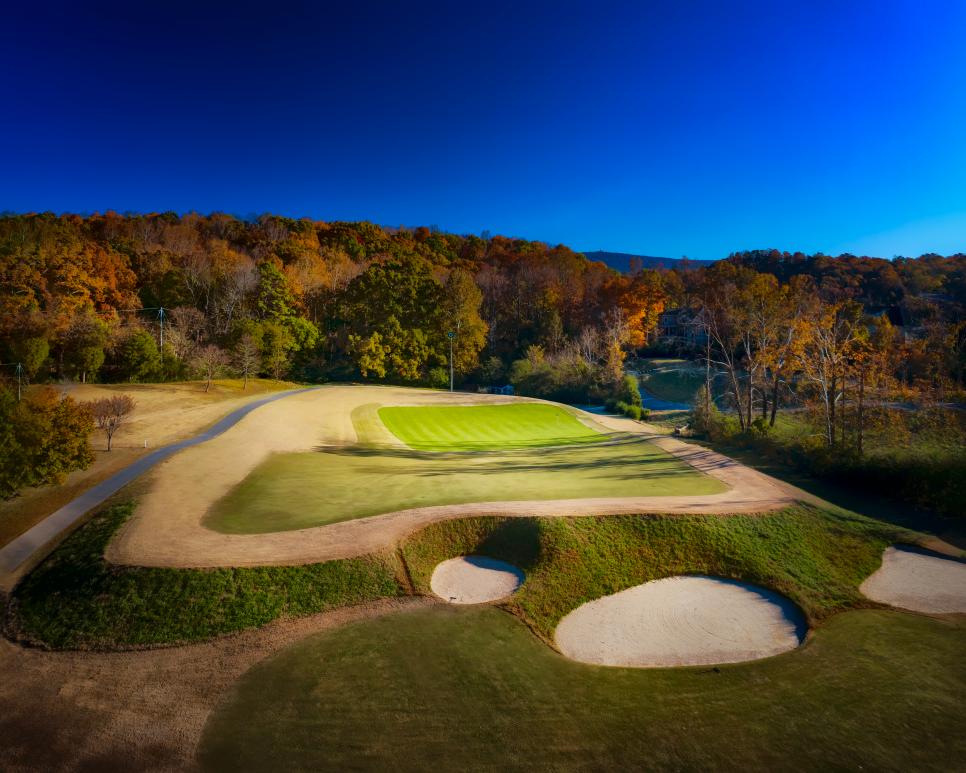
Black Creek
Lawson Whitaker
The sixth hole at Black Creek Club has one of the most fascinating Punchbowl green areas we’ve seen, so much in fact Golf Digest named this par 5 the best sixth hole built in the U.S. since 2000. Opened in 2000, the green sits in at the bottom of a 55,000 square-foot hollow that’s blind from the fairway. Seeing where the balls end up on Punchbowl greens after hitting over fronting mounds is always a thrill, but the walk into Black Creek’s stadium amphitheater at the sixth feels more epic than anything else.
 Private Black Creek Club Chattanooga, TN 3.8 51 Panelists
Private Black Creek Club Chattanooga, TN 3.8 51 Panelists
- Best In State
Brian Silva deserves recognition for being one of the first architects to rediscover, restore and popularize the architecture of Seth Raynor. At Black Creek Club, Silva was able to build his versions of Raynor and C.B. Macdonald’s “ideal holes” like the Short and the Biarritz, but the most remarkable one here, or almost anywhere else, is a Silva original. The par-5 sixth (above) plays across mostly open space, though drives must contend with bunkers jutting into the fairway from the left. The real engagement begins on the second and third shots. Golfers cannot see the green ahead, only a tall, fortress-like embankment of long grass and bunkers. At some point the rampart must be breached, and on the other side awaits a punchbowl arena of more than 55,000 square feet that would make Raynor blush, with sloping banks that funnel shots toward a large, square green perched against a creek. It was ranked by Golf Digest as one of the best holes in America designed after 2000. —Derek Duncan Explore our full review
CHARLESTON MUNICIPAL
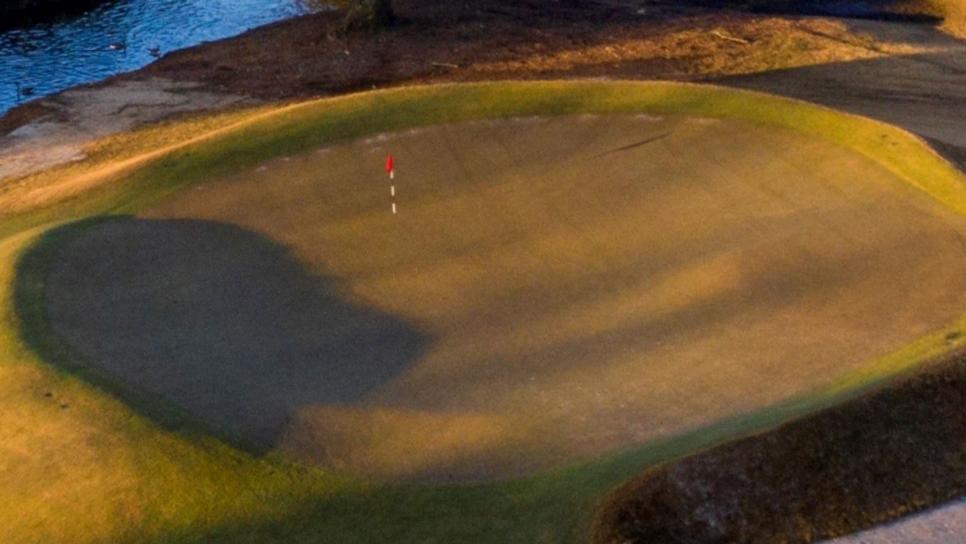
Charleston Municipal
Charleston Municipal
Though the architecture of this course is inspired by the work of Raynor, who built nearby Country Club of Charleston and Yeamans Hall, the par-4 sixth qualifies as a new Punchbowl since it was created by architect Troy Miller during an inventive 2020 remodel of this workhorse muni. This is a mini-Alps version that calls for an approach over a bunker positioned just high enough to obscure the cozy, saucer-like putting surface that flows over several intersecting shoulders.
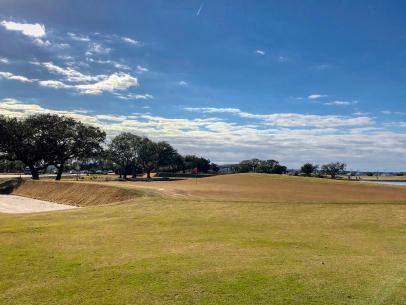 Public Charleston Municipal Golf Course Charleston, SC 3.5 48 Panelists
Public Charleston Municipal Golf Course Charleston, SC 3.5 48 Panelists
A thrifty but artistically ambitious renovation reopened in 2020. The 92-year-old working-class golf course has always been popular, but flooding, wet turf and excessive tree growth negatively impacted playability. Between an allocation of funds from the city (which continues to oversee operations) and private donations collected through an organization called “Friends of the Muni,” approximately $3.5 million was raised, enough to enact significant upgrades without raising green fees. Residents can walk for around $20, and out-of-town players—if they can get a time, can play for under $100. Read the full review here.
Explore our full review More From Places to Play .jpg.rend.hgtvcom.406.271.suffix/1653909255033.jpeg) Bang for your buck The 15 cheapest courses you can play on our new best public ranking CUTALONG AT LAKE ANNAMineral, Va.
Bang for your buck The 15 cheapest courses you can play on our new best public ranking CUTALONG AT LAKE ANNAMineral, Va. 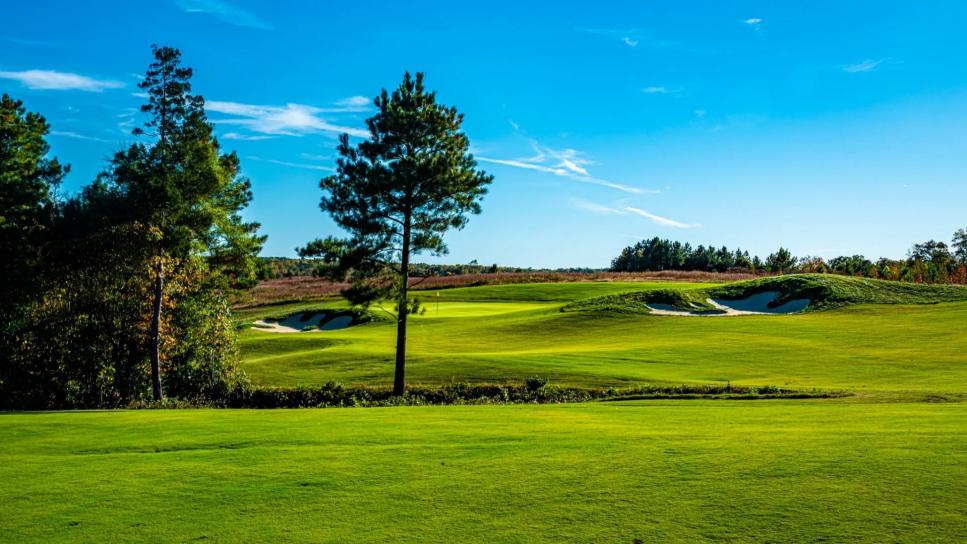
Cutalong
This course, which opened in 2021, is an homage to history and old-time golf with architectural references to Civil War fortifications and designers like Macdonald, Alister MacKenzie and H.S. Colt. Architects Tom Clark and Ron Whitten fortified the green at this par 4 with a punchbowl formation that encircles the right half of the putting surface. Approaches that fly the forward embankment will funnel onto the green, while the open left front edge can receive bouncing shots.
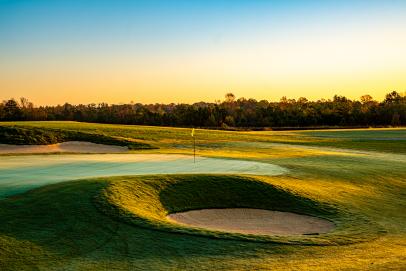 Private Cutalong At Lake Anna Mineral, VA Located midway between Richmond and Washington D.C., this big, exploratory layout by architect Tom Clark and consultant Ron Whitten (Golf Digest architecture editor emeritus) was two decades in the making. Intended to be the “first true Concept Course of the 21st century,” the wait pays off with a design full of motifs of famous British and American holes, a routing that tackles robust topographical movements, small but highly contoured greens, split fairways and Civil War-inspired fortifications. Explore our full review FOUR MILE RANCHCanon City, Colo.
Private Cutalong At Lake Anna Mineral, VA Located midway between Richmond and Washington D.C., this big, exploratory layout by architect Tom Clark and consultant Ron Whitten (Golf Digest architecture editor emeritus) was two decades in the making. Intended to be the “first true Concept Course of the 21st century,” the wait pays off with a design full of motifs of famous British and American holes, a routing that tackles robust topographical movements, small but highly contoured greens, split fairways and Civil War-inspired fortifications. Explore our full review FOUR MILE RANCHCanon City, Colo. 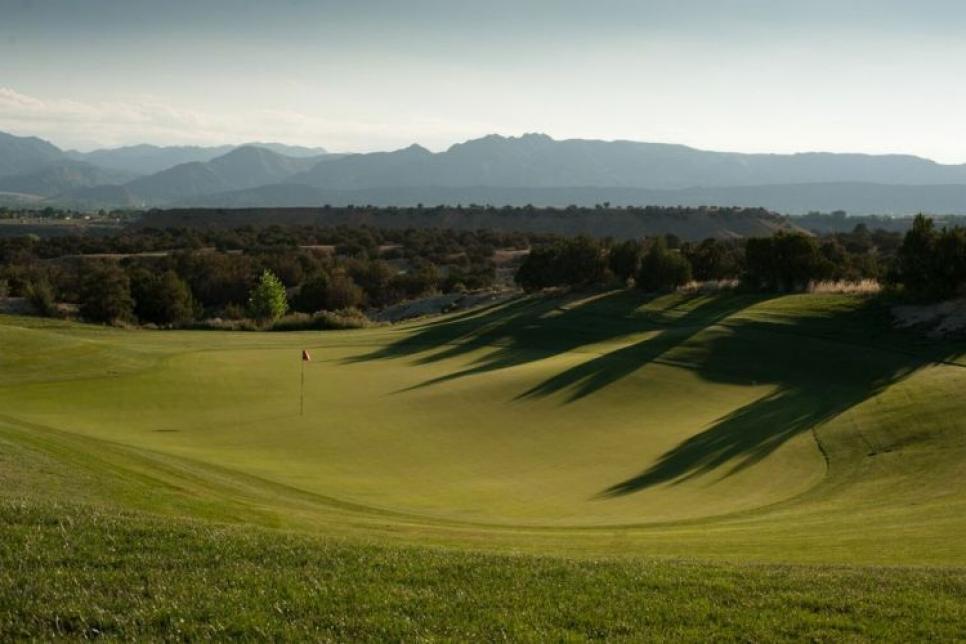
Four Mile Ranch
There are perhaps a dozen different Jim Engh-designed Punchbowl-like greens that we could have chosen for this list, and more than one at Four Mile Ranch in the foothills of Colorado near Pueblo. No modern architect has been more bowl-curious than Engh, who understood the thrill players get seeing, and sometimes not seeing, their ball redirect off a bank toward the cup. The Punchbowl par-3 14th at Four Mile Ranch might be his most conventional requiring a blind tee shot over the top of a ridge complete with a rock aiming point like Lahnich’s Dell Hole.
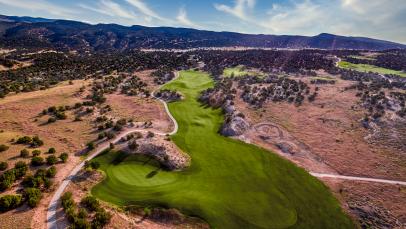 Public Four Mile Ranch Golf Club Canon City, CO 3.5 17 Panelists There are no bunkers on this Jim Engh design that is framed by mountains all around. Shale mounds take the place of sand on many holes, including many other unique Engh design features, such as several punchbowl greens, blind shot and wild green slopes. As one of our panelists put it: “vastly underrated among the state’s public courses.” Explore our full review GAMBLE SANDSBrewster, Wash.
Public Four Mile Ranch Golf Club Canon City, CO 3.5 17 Panelists There are no bunkers on this Jim Engh design that is framed by mountains all around. Shale mounds take the place of sand on many holes, including many other unique Engh design features, such as several punchbowl greens, blind shot and wild green slopes. As one of our panelists put it: “vastly underrated among the state’s public courses.” Explore our full review GAMBLE SANDSBrewster, Wash. 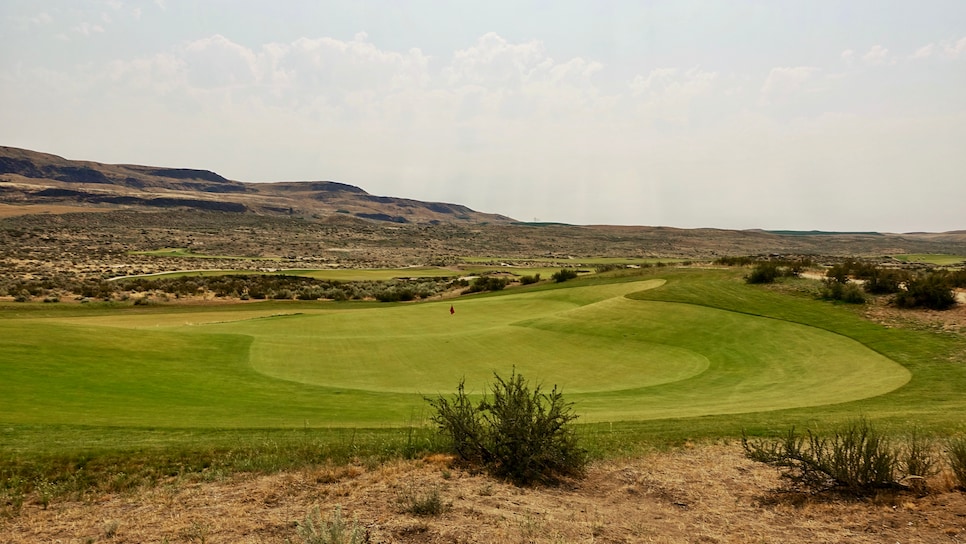
Gamble Sands
Jon Cavalier
David McLay Kidd isn’t one to fawn over Golden Age architecture and the precedent of Macdonald and Raynor, but he knows an opportunity when he sees one. The greensite at the long par-3 16th at Gamble Sands presented the chance to do something different by notching the right half into an upslope forming a bowled, semi-blind hole location that spills severely down into the lower half of the green. It’s different than anything else on the course, but Punchbowls should be different.
 Public Gamble Sands Brewster, WA 4.5 124 Panelists
Public Gamble Sands Brewster, WA 4.5 124 Panelists
- Second 100 Greatest
- 100 Greatest Public
- Best In State
The winner of Golf Digest’s Best New Course of 2014 award, Gamble Sands sits atop a sprawling, treeless plateau of sandy desert overlooking Washington’s Columbia River Valley. The extremely playable layout is oversized in every respect, with enormously wide fairways, gigantic greens, no rough and some of the most panoramic vistas around. In using “friendly contours” that divert shots away from bunkers and toward targets, designer David Kidd wants everybody to have fun. He hopes good players will relish opportunities to score low and high handicappers will post their best round ever. With three reachable par 4s on the 18, that’s a possibility. Of course, Gamble Sands was Kidd’s inspiration for Mammoth Dunes. Explore our full review THE CLUB AT LAC LA BELLE Oconomowoc, Wis. 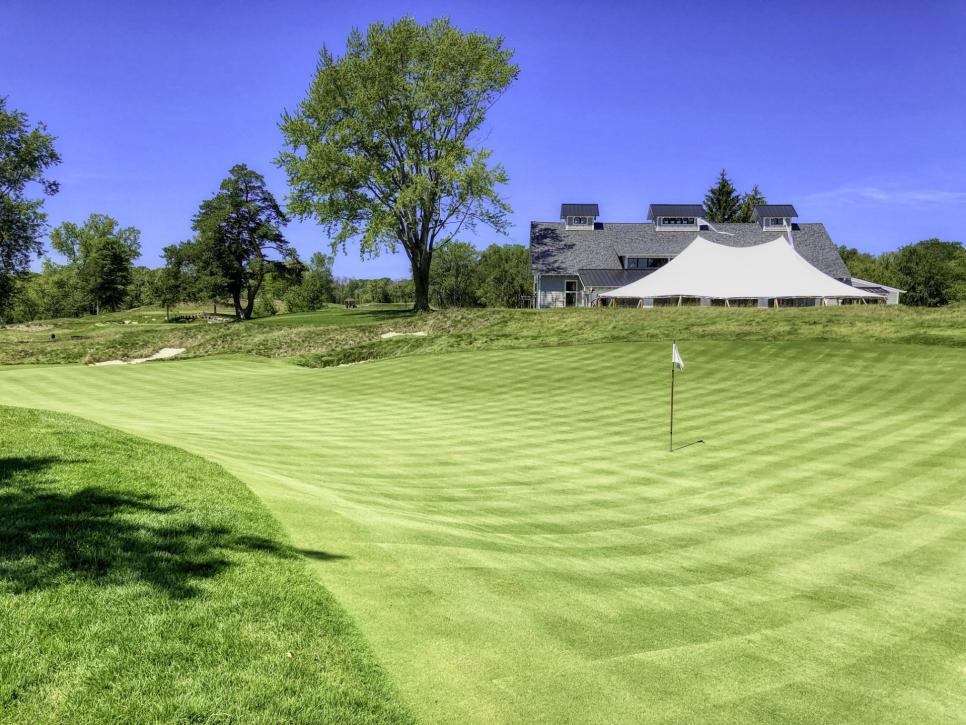
Lac La Belle
Lac La Belle’s Punchbowl 18th, designed by architect Craig Haltom during a major transformation of this public course west of Milwaukee in 2018, is notable for its size. Part of a long, slightly uphill par 4, the green rises upward between two high wings and a backstop that rolls up into a massive putting course near the clubhouse. The 13th green here also has a bowl-like design, but there’s nothing we’ve seen that’s quite comparable to the wild 18th.
 Public The Club At Lac La Belle Oconomowoc, WI 4.1 61 Panelists
Public The Club At Lac La Belle Oconomowoc, WI 4.1 61 Panelists
- Best In State
Golf was first played on the site of this course in 1896 and attracted the biggest names of the day. Its fortunes declined over the next 100 years, however, partially due to poor drainage. Several years ago, the Morse family purchased the course, and the revival has been inspired. Wisconsin-based architect Craig Haltom was given land for four new holes and reengineered the others using strong bunkering to create engaging strategies and some of the most whimsical, multilevel greens anywhere, several over 10,000 square feet in size. Explore our full review More from Golf Digest 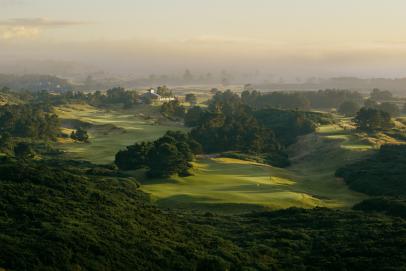 Eye on Courses The 13 best Redan holes that you can actually play LANDMANDHomer, Neb.
Eye on Courses The 13 best Redan holes that you can actually play LANDMANDHomer, Neb. 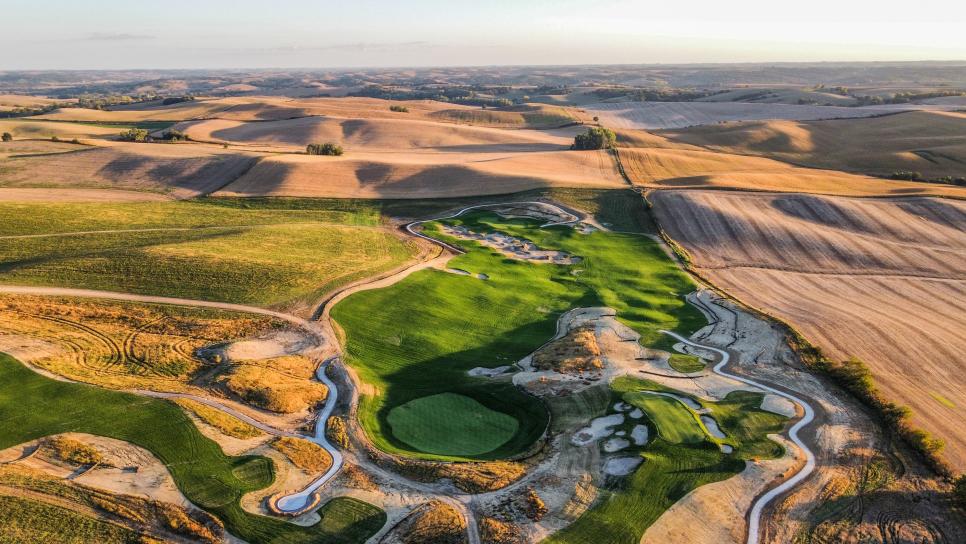
Landmand
Ben Vigil
Speaking of big Punchbowls, there might be none on Earth larger than Landmand’s 10th, designed by Rob Collins and Tad King in the choppy Loess Hills of northeast Nebrraska. It clocks in at over 19,000 square feet, or nearly half an acre, and unlike many others there’s an opening at the front that allows balls to be bounced on if needed. The fun really begins once you’re “inside” the yawning maw of the two-level putting surface where you must figure out how to lag putts to widely spaced hole locations.
 Public Landmand Homer, NE
Public Landmand Homer, NE
Actor Nick Cage once ate a live cockroach for a film he was shooting. Later, when asked why—he could have eaten a pretend insect—he responded, “Anything less wouldn’t be real.”The conceit is that at times the only way to fulfill the potential of a given situation—a movie scene, a piece of art, a military offensive—is to push as far and aggressively as possible. This principle applies to Landmand, a new design in northeastern Nebraska about 10 miles from Sioux City, Iowa. The course sits on a vast, elevated section of loess formations with eroded furrows and valleys. It winds across the bluffs and between valleys, and from the tops of the ridges horizon views of 20 miles or more are possible, filling the landscape with a feeling of unlimited proportion. Given the setting, it’s impossible to discern the scale of the features in the near and middle distance, and the only way for architects Rob Collins and Tad King to make the golf look like it fit against the endless backdrops was to construct fairways 80 to 100 yards wide and greens that are, cumulatively and in some cases individually, the largest in the United States. Anything less wouldn’t be right. Read our full review here.
Explore our full review More from Golf Digest 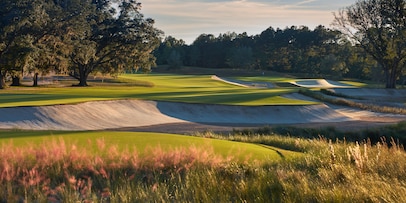 Courses We ranked every PGA Tour course—from best to worst OLD BARNWELLAiken, SC
Courses We ranked every PGA Tour course—from best to worst OLD BARNWELLAiken, SC 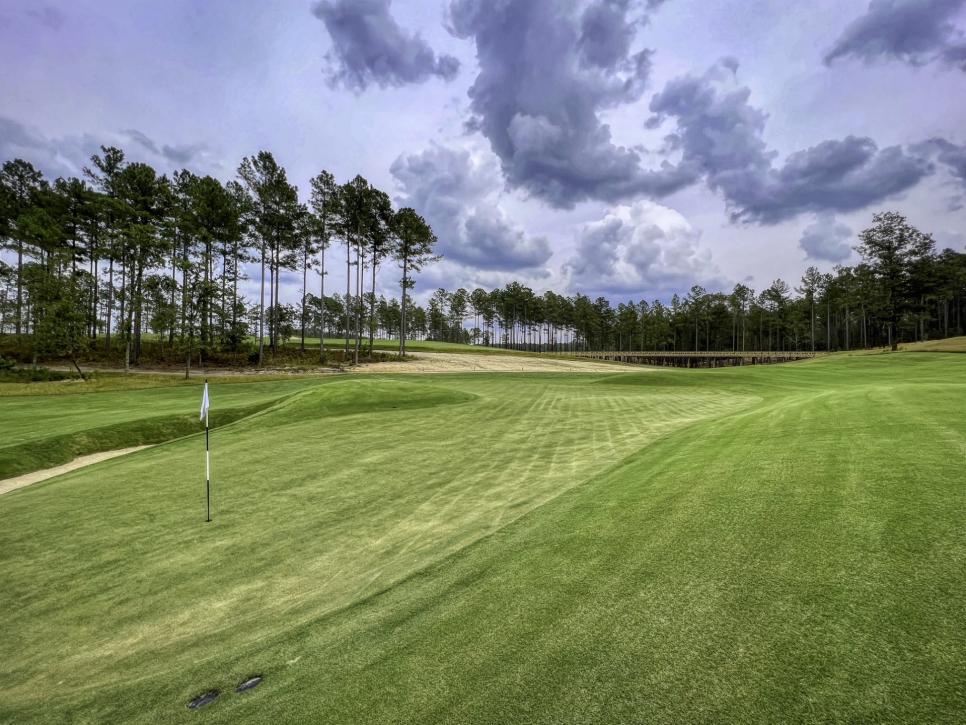
Old Barnwell
Old Barnwell’s eight green is of a certain class of taco-like punchbowls that are reminiscent of the Dell Hole at Lahinch, with a narrow green saddled between a opposing high mounds. It’s also a variation of the fourth green at Barnbougle Dunes in Tasmania where architect Brian Schneider (who designed Old Barnwell with Blake Conant) worked with Tom Doak. Balls hit to front and middle pins can bank off the flanges and settle close to the hole, while the more open back left hole locations require extra calculation an precision.
SAND VALLEYNekoosa, Wis.
The green at Sand Valley’s 17th hole (pictured at the top of this story) was originally positioned 60 yards short of its current location. That was before Bill Coore, during a walk-through with Mike Keiser, hiked over the dune behind the proposed greensite and noticed the wide, hidden basin that became the hole’s unforgettable Punchbowl. The tee shot at the long par 3 is now one of the most entertaining on the course as players first wait to see if they had enough club to carry the front rampart, and then breach the bowl to find out where the shot settled if so.
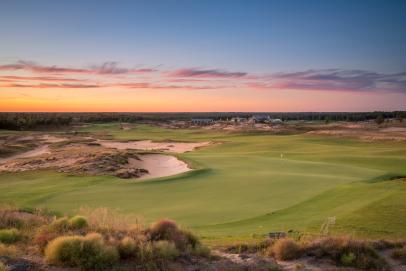 Public Sand Valley Nekoosa, WI 4.5 482 Panelists
Public Sand Valley Nekoosa, WI 4.5 482 Panelists
- Second 100 Greatest
- 100 Greatest Public
- Best In State
Sand Valley is the fifth course that the firm of Coore and Crenshaw has designed for resort maven Mike Keiser, and the first not located close to an ocean. No matter. It’s still on a thousand acres of rolling sand hills in Central Wisconsin, and Coore and Crenshaw were given carte blanche to route their course. (Rumor has it Coore routed a hole outside the property line and Keiser reluctantly bought that additional parcel.) Given the name, many conclude Sand Valley is a combination of Nebraska’s Sand Hills Golf Club and New Jersey’s Pine Valley. But Sand Valley has its own personality, with some dual fairways, gigantic sand spits, enormous greens and even a hidden putting surface. Sand Valley was Golf Digest’s Best New Course of 2017. Explore our full review SEDGE VALLEYNekoosa, Wis. 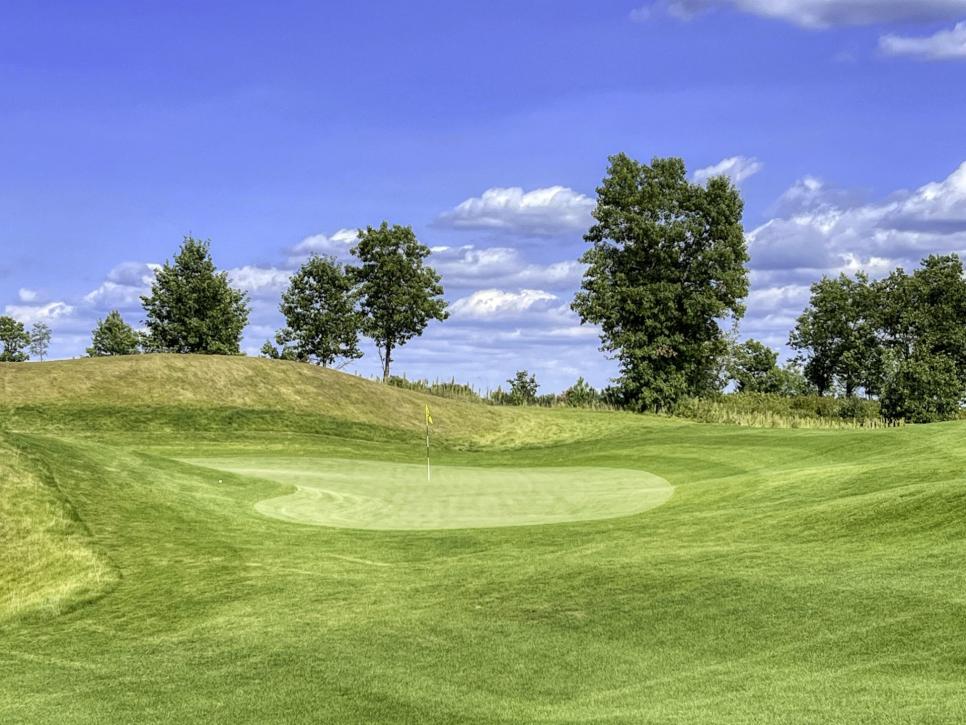
Sedge Valley
The green at the new Sedge Valley course at Sand Valley, designed by Tom Doak and set to open summer 2024, is a replica of the fourth green at Barnbougle Dunes, which he also designed (see: Old Barnwell). A short par 4 from an elevated tee, players have the option of trying to drive the green on a direct but blind line over a lateral ridge, playing to a hidden upper fairway to the right, or hitting to a lower fairway for a short pitch. Each decision should be based on where the hole is cut on the L-shaped green.
SCOTTSDALE NATIONAL 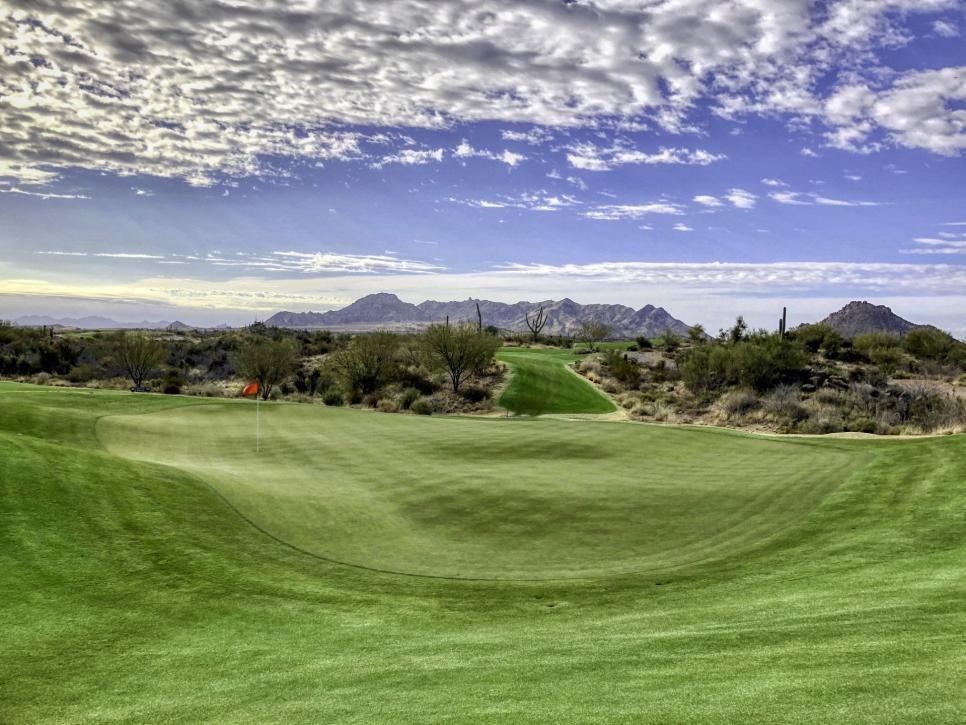
Scottsdale National
The diminutive green at this par 5 isn’t a full Punchbowl in the traditional mold, but the ball will feed off surrounding slopes toward, or away from, certain hole locations. Built for owner Bob Parsons by architects David Kahn and Tim Jackson, it’s one of many creative putting surfaces that keep players off balance alternating between small shot-making targets like the fourth and large sprawling putting surfaces like the 20,000-square-foot behemoth at the fifth.
STREAMSONG BLACKBowling Green, Fla. .jpg.rend.hgtvcom.966.544.suffix/1644519945505.jpeg)
LC Lambrecht
The Punchbowl eighth at Gil Hanse and Jim Wagner’s Black Course at Streamsong is radical at first sight. Drone photos make it look like a ring of flour ready to be kneaded into a pasta dough surrounding a deep well with heavy internal movements. As with all good Punchbowls, it can turn good shots into great shots depending on the bounce, and indifferent shots into bad if they can’t escalade of front of the entrenchment.
.jpg.rend.hgtvcom.406.229.suffix/1644519945505.jpeg) Public Streamsong Resort: Black Bowling Green, FL 4.6 326 Panelists
Public Streamsong Resort: Black Bowling Green, FL 4.6 326 Panelists
- Second 100 Greatest
- 100 Greatest Public
- Best In State
Gil Hanse’s Black Course at Streamsong, Golf Digest’s Best New Public Course of 2018, sits a mile south of the resort’s Red and Blue Courses, with its own clubhouse and its own personality. Reshaped from a decades-old phosphate strip mine that lacking tall spoil mounds, Hanse provided strategic character by building a hidden punchbowl green at nine, dual putting surfaces at 13, incorporating a meandering creek on the par-5 fourth and a lagoon cove to guard the 18th green. Both the putting surfaces and the chipping areas surrounding them were grassed in MiniVerde, and today both are mowed at a single height, resulting in the biggest, most complex greens found on our national ranking. One Streamsong insider calls the Black greens “polarizing;” we call them tremendous fun. Explore our full review
Of note: The resort’s new par-3 course, The Chain, features one of the most impressive Punchbowls built in modern architecture. Bill Coore and Ben Crenshaw mined a ton of sand, built a hole in the ground, making it one of the tallest Punchbowls to be found in North America. The 11th hole plays over a lake and can play as long as 189 yards.
More from Golf Digest 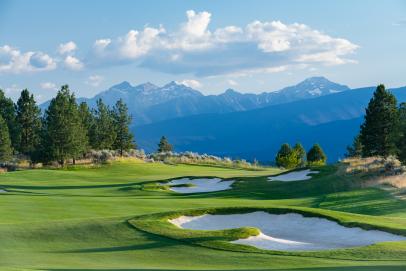 Deeper dive The First 25 Out: These courses just missed our latest ranking of the 200 best courses THE BATHS AT BLACKWOLF RUNKohler, Wis.
Deeper dive The First 25 Out: These courses just missed our latest ranking of the 200 best courses THE BATHS AT BLACKWOLF RUNKohler, Wis. 
The Baths
The Badger State should be rechristened the Punchbowl State, and The Baths, a 10-hole par 3 course comprised of holes modeled after some of the most famous in the U.K. (as was Macdonald’s m.o. at National Golf Links), has one of the best. Chris Lutzke, who for years worked closely with Pete Dye, set the fourth green into an incline so it sits like a catcher’s mitt waiting to frame incoming short-irons and wedges. Some areas funnel, but different tiers and elevations also repel shots to various low points.
THE LIDONekoosa, Wis. 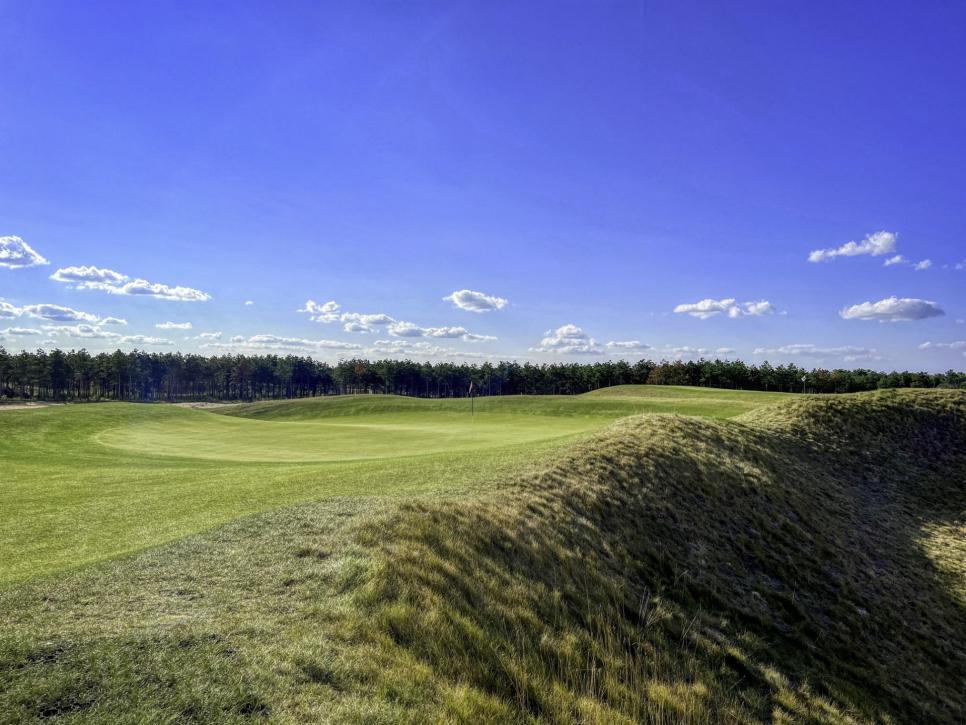
The Lido
Though the hole was originally built in 1914, it disappeared in the 1940s with the rest of Macdonald’s Lido course when the property was converted to a Naval base. This new version of the 12th, however, is an exacting replica of the original based on computer simulations and GPS technology. This may be the most demanding Punchbowl in existence, a 433-yard dogleg requiring an all-carry second shots up and over a pair of fronting bunkers, something that would have been nearly impossible using the era’s hickory shafts and Haskell balls.
THE TREE FARMAiken, S.C. 
Tree Farm
The par-5 16th is part of an exciting four-hole finish at Zac Blair’s Tree Farm where birdies and eagles—and surely some bogeys—flip matches back and forth coming down the homestretch. It’s an homage to some of the classical Punchbowls of Macdonald and Raynor that Blair is so fond of, built by designer Kye Goalby. Once players cut blind drives across a flank of bunkers they’ll hit long seconds that need to carry or chase over a shoulder of land less they be faced with an difficult-to-stop blind pitch from just short of the hill.
More from Golf Digest 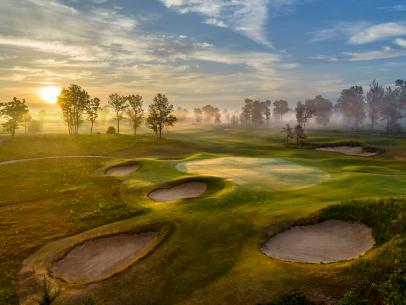 Fun Ranking* The 13 most fun golf courses in the U.S., according to our expert
Fun Ranking* The 13 most fun golf courses in the U.S., according to our expert
• • •
Explore Golf Digest’s recently relaunched Places to Play community, where you can add star ratings and reviews for all the courses you play. We’ve collected tens of thousands of reviews from our course-ranking panelists to deliver a premium experience, which includes experts’ opinions, bonus course photography and videos, plus much more. Check it out here!
This article was originally published on golfdigest.com



